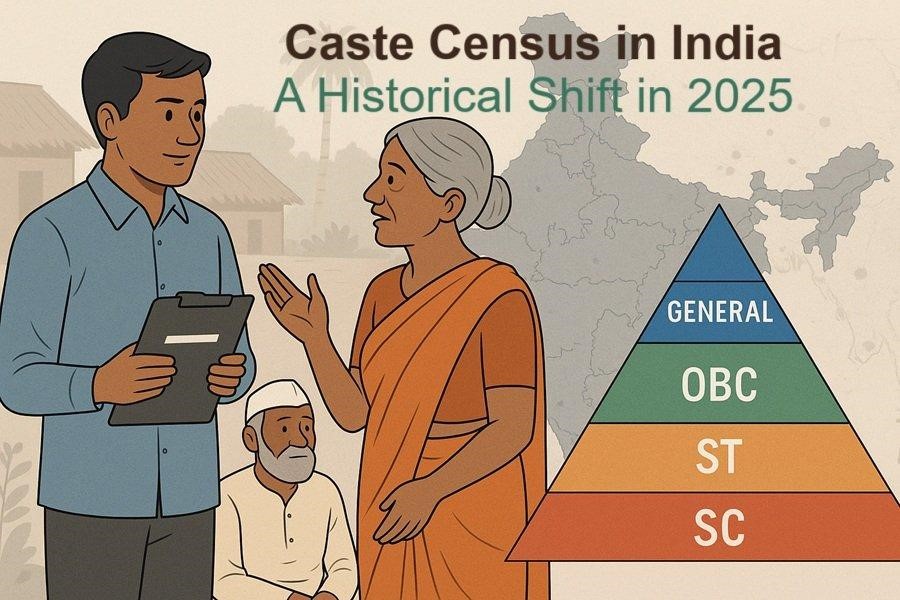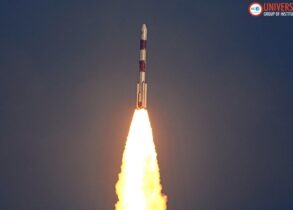CASTE CENSUS IN A FRAUGHT POLITICAL MOMENT: SELFIE OF THE NATION
CASTE CENSUS IN A FRAUGHT POLITICAL MOMENT: SELFIE OF THE NATION
Why in the News?
The upcoming Census 2026-27 is expected to be unprecedented in several ways, particularly in its potential impact on the Indian caste system and Indian politics. As discussions intensify about when the census will take place and its enumeration date, understanding the census definition and its implications is crucial for grasping the significance of this event:
- It will be the first national census following rising demands for a nationwide caste-based enumeration, prompted by recent state-level caste surveys (like in Bihar). This raises expectations that data on caste composition might be included or debated, potentially reshaping our understanding of the Hindu caste structure and caste in Indian society in modern India. The process of caste data collection is likely to be a central focus, given its potential to provide a comprehensive list of castes in India.
- The Census will occur just before or alongside the proposed delimitation exercise (post-2026), which could redraw parliamentary and assembly constituencies based on updated population count data — a politically sensitive issue that may affect state representation in the national legislature and impact electoral politics. This process is expected to reveal significant demographic shifts since the last delimitation.
Why the Upcoming Census 2026–27 is Unique: Key Reasons
- Renewed Focus on Caste Enumeration ○ Growing media and political attention on counting castes beyond SCs and STs. ○ Calls for nationwide caste enumeration follow state-led surveys in Bihar, Karnataka, and Telangana. ○ While caste was last counted nationally in the 1931 census, caste data for SCs/STs has continued post-Independence. The upcoming census aims to provide updated OBC data, addressing a long-standing gap in caste statistics.
- Delimitation Exercise on the Horizon ○ A new delimitation exercise is expected, likely to redefine the number and boundaries of parliamentary and assembly constituencies. ○ This will determine the political weight of various states in the Union. ○ While delimitation has occurred three times before, the current formula is based on the 1971 Census; boundaries were last redrawn using the 2001 Census.
- A Politically Charged Conjuncture ○ What makes this Census truly unique is the timing — both caste enumeration and delimitation are unfolding in a politically sensitive environment. ○ The confluence of identity politics, federal concerns, and representational equity makes the stakes particularly high in this cycle, potentially impacting political mobilization strategies for parties like the Congress and BJP.
Changed Context of Delimitation:
- 84th Constitutional Amendment (2002) Under the Vajpayee-led NDA government, the allocation of Lok Sabha seats was frozen based on the 1971 Census until after the first Census post-2026, to address fears of northern states gaining more seats due to higher population growth.
- North-South Population Imbalance Intensifies: In the 2020s, demographic projections show a widening gap between high-growth northern states and population-stabilized southern states (except Himachal Pradesh). ○ This intensifies concerns that southern states may lose political weight despite contributing more to population control and economic output. ○ Perception of Injustice: There’s a strong narrative that the south is being “punished” for better governance, while the north is “rewarded” despite lagging indicators, exacerbating the north-south divide.
- Electoral Strategy Concerns: The BJP’s electoral dominance in the north and limited presence in the south fuels speculation that delaying the Census beyond 2026 may be a strategic move to control the timing of delimitation. ○ This delay could offer the ruling party a political bargaining tool ahead of the 2029 general elections.
Caste Enumeration
- Historical Background: ○ The last nationwide caste count was in the 1931 census, which was criticized by nationalists as a colonial strategy to divide Indian society. ○ Despite this, the colonial Census led to the aggregation of caste identities, laying the foundation for caste-based coalitions.
- Post-Independence Caste Politics: Though formal caste counts were avoided, caste-based identity politics grew, peaking during the Mandal upsurge of the 1990s. ○ Recent state-level surveys (e.g., in Bihar and Karnataka) have renewed demands for a nationwide caste census.
- Current Political Moment: The issue now arises in a post-Mandal era, where OBC politics and reservation demands are central to electoral competition. ○ Thus, caste enumeration today carries high political stakes, unlike earlier decades, and could significantly impact political mobilization for parties like the BJP and Congress.
Redefine Caste Politics
Ending Statistical Invisibility of “Upper” Castes
- For the first time since Independence, the Census may count all castes, not just Scheduled Castes and Scheduled Tribes.
- This will end the statistical anonymity of “forward” or “upper” castes who have: ○ Gained disproportionately from state-led development. ○ Benefited even more from market-led liberalisation in the past two decades, potentially impacting the middle class.
- Challenges the dominant narrative (led by upper castes) that welfare benefits are exclusive to backward groups, ignoring state-enabled market gains for the privileged.
- Even with basic data, such a Census will enable a deeper understanding of caste-based inequality, including how a seemingly caste-neutral state has often deepened caste disparities.
Shift from Aggregation to Disaggregation Phase in Caste Politics
- Over the last 3–4 decades, caste politics has moved from aggregation (Mandal-era coalitions) to disaggregation: ○ Rise of sub-caste assertions within broad official categories like OBC, SC.
- The Census may provide disaggregated data on individual castes within these clusters, including lower OBCs. ○ This could expose internal hierarchies and challenge dominant political formations built on broad caste categories.
- Encourages critical questioning of existing political and social coalitions, not limited to caste but also religion, region, and ideology.
Implications for Political Mobilisation
- Hard data on inequality across castes may: ○ Force dominant ideologies (e.g. Hindutva, caste-based identity politics, regionalism) to address real disparities. ○ Lead to emergence of new, interest-based solidarities, cutting across traditional caste/community lines.
- This could reshape political discourse, pushing for more inclusive and equitable frameworks of unity.
Global Trends & the Threat of “Alternative Facts”
- In many authoritarian regimes, inconvenient truths are countered by “alternative facts” or are prevented from surfacing altogether.
- There’s a risk that such global tendencies may influence the integrity of Census data collection in India.
- Hope remains that the Census machinery remains insulated from political pressure or data distortion.
Final Thought: The Census as a National Self-Portrait
- Ultimately, the Census is “a selfie of the nation” — A factual, collective self-portrait painted by the government on behalf of the people.
- Its accuracy and inclusiveness are crucial for democracy, justice, and meaningful development.
Way Forward for Census 2026–27
- Ensure Transparency and Integrity ○ Safeguard the Census process from political interference or data manipulation. ○ Build public trust by maintaining transparency in methodology, data handling, and dissemination.
- Include Comprehensive Caste Data ○ Conduct a full-scale caste enumeration to capture the social realities of all communities. ○ Use this data to inform evidence-based policymaking on inequality and affirmative action.
- Protect Institutional Autonomy ○ Strengthen the independence of the Registrar General and Census Commissioner to resist external pressures. ○ Empower institutions to ensure scientific and impartial data collection.
- Address North-South Federal Tensions ○ Use delimitation and population data sensitively, avoiding penalisation of states that have successfully controlled population growth. ○ Explore compensatory mechanisms (e.g., fiscal devolution, Rajya Sabha empowerment) to maintain federal balance.
- Foster Social Dialogue ○ Encourage public discourse on caste, representation, and inequality using accurate data. ○ Involve civil society, academia, and state governments in analysing and disseminating findings constructively.
- Leverage Technology and Data Security ○ Adopt robust digital tools and safeguards for efficient, tamper-proof data collection and storage. ○ Ensure privacy and confidentiality of individuals while enabling access to anonymized datasets for research. ○ Consider the digital divide impact on data collection and representation.
- Promote Inclusive Development Planning ○ Use disaggregated data to design targeted welfare programmes addressing real needs. ○ Focus on intra-group inequalities within broader categories like SC, ST, and OBC.
- Avoid Delay and Politicisation ○ Stick to the 2026–27 timeline to avoid perceived manipulation for electoral gain. ○ Depoliticise the Census by treating it as a national democratic exercise, not a partisan tool.
- Prepare Public for Findings ○ Run awareness campaigns to explain the purpose and benefits of caste and population data collection. ○ Help manage public expectations and pre-empt misinterpretation of statistics.
- Use Data for Social Justice, Not Division ○ Ensure that data generated leads to policies that reduce inequality, rather than fuel social fragmentation. ○ Build solidarities based on shared interests, not just identity markers.
- Consider Language and Ethnoreligious Groups ○ Include comprehensive language data in census to capture linguistic diversity. ○ Address concerns of ethnoreligious groups to ensure inclusive representation.
- Address Economic Factors ○ Consider the impact of economic slowdown on population trends and social mobility. ○ Analyze how caste intersects with economic factors in shaping social reality.
- Enhance Census Participation ○ Develop strategies to increase census participation across all communities. ○ Address concerns about data misuse to build trust in the enumeration process.
- Learn from Past Censuses ○ Analyze data from the 2011 census and historical censuses like the 1931 census to identify trends and improve methodologies.
- Collaborate with Research Institutions ○ Partner with institutions specializing in caste sociology and demographic studies. ○ Utilize expertise from the Socio-Economic and Caste Census (SECC) for improved data collection and analysis.
- Address Communal Sensitivities ○ Be mindful of potential anti-Muslim prejudice in data collection and interpretation. ○ Ensure fair representation of all religious communities in the census process.
By implementing these measures, the Census 2026-27 can serve as a crucial tool for understanding India’s evolving social landscape and informing policy decisions that promote equality and development for all citizens. The reference date for the census will be crucial in capturing accurate demographic data, and lessons can be drawn from other countries’ experiences, such as the census in England, to improve methodologies and address potential challenges.
Mains question (250 words):
Discuss the significance of the upcoming Census 2026–27 in the context of caste enumeration and delimitation. How might it reshape India’s socio-political landscape and federal balance?







